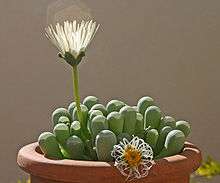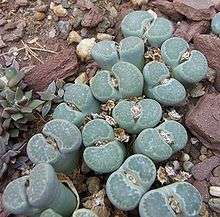Leaf window

Leaf window, also known as epidermal window,[1] is a specialized leaf structure consisting of a translucent area where sunlight can enter into the interior surfaces of the plant's modified leaf where photosynthesis can occur. This is also known as fenestration.[2][3] The translucent structure may include epidermal tissue, and in some succulent plants it consists of several cell layers of parenchyma, which may also function as water-storage tissue.[4] It can appear as a large continuous patch, a variegated or reticulated region, or as numerous small spots. This structural adaptation is found in certain succulent plants native to arid climates, which allow much of the plant to remain beneath the soil surface where it is protected from desiccation of extreme winds and heat while optimizing the absorption of light by increasing the photosynthetic surface area. Many of the known species containing leaf windows are native to South Africa and neighbouring countries.
Functions
The primary function of the translucent windows on the leaf epidermis is to increase the absorption of radiant energy, and thereby the rate of photosynthesis.[5] Epidermal windows are commonly situated at the apex of leaves, allowing unobstructed sunlight to be captured and utilized even when the plant is buried below the surface of the soil.[6] The absence of stomata in the translucent tissue of the window prevents water loss in the plant. This allows succulents to minimize the exposure of leaf surface area to the outside environment and reduce the risk of desiccation under intense heat. The actual green, photosynthesizing surface is hidden in the underground part of the plant, so that it collects only the diffused light that strikes the windows, which in turn focusses and channels it to the leaves' inside surface.[1] Experiments in the Lithops species of succulents, have shown that the size of leaf windows correlates inversely with habitat solar irradiance.[7] Epidermal windows of plants growing in regions of high irradiance and low-rainfall were smaller than of those plants which grew in cloudy, high-rainfall regions. It is presumed that the size variation evolved to allow individual plants to set their optimal uptake of sunlight based on its environment.
Carnivorous plants can also make use of by growing traps (highly modified leaves) which use sunlight to lure and/or confuse insects and increase the effectiveness of the trap.[8]
Species

Genera of plants with numerous species having translucent epidermal windows include:
- Cephalotus spp.
- Conophytum spp.[9]
- Darlingtonia spp.
- Fenestraria spp.
- Frithia spp.
- Haworthia spp.
- Lithops spp.
- Nepenthes spp.; known only from N. klossii and N. aristolochioides.
- Pleiospilos spp.
- Sarracenia spp.
- Peperomia spp.: notably P. columella[4] and P. nivalis
Several other plant species have epidermal windows:
Plants with leaf windows are sometimes known as window plants, though this is also the common name used to refer to Fenestraria rhopalophylla.
See also
- Perforate leaf, leaves have holes
References
- 1 2 Egbert, K. J.; Martin, C. E.; Vogelmann, T. C. (2007-06-19). "The influence of epidermal windows on the light environment within the leaves of six succulents". Journal of Experimental Botany. 59 (7): 1863–1873. doi:10.1093/jxb/ern105. Retrieved 2016-08-17.
- ↑ Hickey, M.; King, C. (2001), The Cambridge Illustrated Glossary of Botanical Terms, Cambridge University Press
- ↑ Beentje, H.; Williamson, J. (2010), The Kew Plant Glossary: an Illustrated Dictionary of Plant Terms, Royal Botanic Gardens, Kew: Kew Publishing
- 1 2 Christensen-Dean, G.A.; Moore, R. (1993), "Development of Chlorenchyma and Window Tissues in Leaves of Peperomia columella", Annals of Botany, 71 (2): 141–146
- ↑ Egbert, K. (March 2002). "The Influence of Leaf Windows on the Utilization and Absorption of Radiant Energy in Seven Desert Succulents". Photosynthetica. doi:10.1023/A:1020129820295. Retrieved June 10, 2016.
- ↑ "Windowed". www.cactus-art.biz. Retrieved 2016-06-10.
- ↑ Martin, C. E.; Brandmeyer, E. A.; Ross, R. D. (2013-01-01). "Ecophysiological function of leaf 'windows' in Lithops species - 'Living Stones' that grow underground". Plant Biology (Stuttgart, Germany). 15 (1): 243–247. doi:10.1111/j.1438-8677.2012.00672.x. ISSN 1438-8677. PMID 23043320.
- ↑ "Predatory Plant: Lure of the Cobra Lily". KQED Science. Retrieved 2016-06-10.
- ↑ Opel, M.R. (2005), "Leaf Anatomy of Conophytum N. E. Br. (Aizoaceae)", Haseltonia: 27–52, doi:10.2985/1070-0048(2005)11[27:LAOCNE]2.0.CO;2